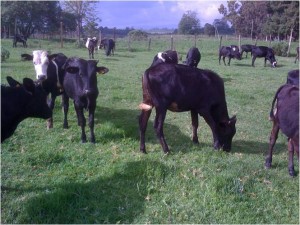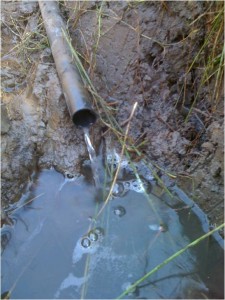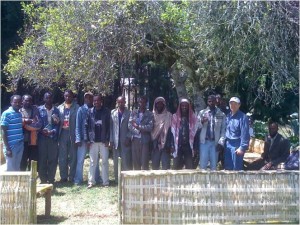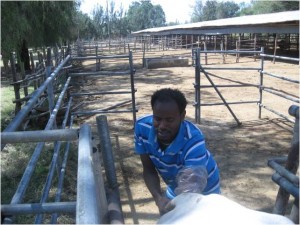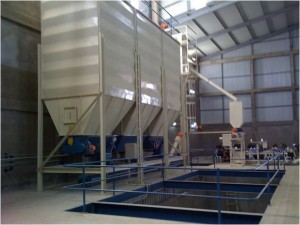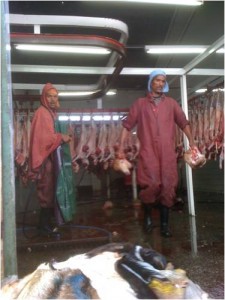Lonny Ward
Research & Development – Dairy and Beef Initiatives
The main goal of Morrell Agro Industries’ dairy initiative is to get a dairy and milk processing facility up and running in Ethiopia. It has proved to be a bigger challenge than MAI employees initially thought, but progress is slowly being made.
Animal Improvement
Improving the animal quality and production in Ethiopia is one of the most important issues that Morrell Agro Industries has been striving to improve. The average dairy cow in Ethiopia produces about a half gallon of milk each day. That amount could easily be doubled or tripled to five or six gallons per day if additional genetics are brought into the country.
Holstein cattle, which are a common breed in the United States, don’t do as well in starvation mode, which is typical for cattle in Ethiopia, as the native Arsi cattle do. Research centers in the country are producing half-Holstein, half-native cattle crosses so that they produce more milk than the native cattle and hold up better in tough environments than the Holstein cattle.
But, if Holstein cattle are feed correctly, they can perform fantastic in the country. Kokosa is a tremendously great environment for dairy cattle. Nothing like it can be found in the United States, where it is either too hot or too cold for dairy cattle. Ethiopia is great country, and MAI is excited to see what they can accomplish there. The first step is to improve the cattle breeds in the country.
Lonny Ward has been working to improve the animals in Ethiopia through embryo transfer and artificial insemination. Embryos from the United States are collected, frozen and shipped to Ethiopia, and then implanted in the native Ethiopian cattle. If successful, a calf with 100% US genetics will be born in the country. Semen from the United States is also brought in to Ethiopia and bred with the native cattle, which results in a half US genetics calf. The end goal of utilizing both embryo transfer and artificial insemination is to increase cattle production and quality throughout the country.
The first successful embryo transfer, in Ethiopia, resulted in the birth of a Holstein-jersey calf at the Adami Tulu Animal Research Center in the beginning of May. Five more calves have since been born. On Lonny’s last visit to the country, eighty additional embryos were implanted in the native cows, and he is waiting to hear about the conception rates. The previous conception rates were poor, and if they are similar in this round of embryos transfers then about twelve births can be expected. In the United States, thirty calves would be expected from a similar amount of embryos.
In Kokosa, MAI originally purchased arsi heifers, a local Ethiopian breed, but when Lonny looked the heifers over, he determined that they were too small to use in embryo transfer. Lonny purchased sexed, female jersey semen in the United States and brought to them to Ethiopia where they were bred with the cattle in Kokosa. Two settled, and the first calf from artificial insemination was born May 24th. One more calf is on the way. MAI also sold their arsi heifers and replaced them with Boran heifers. Lonny and Abera Chala traveled to the southern region of Ethiopia, where they were able to find some good quality animals.
Property Enhancement
Morrell Agro Industries has leased property from the Ethiopian government in Kokosa. It is a beautiful mountain ranch, but it needs to be developed.
Two deep wells have completely been dug at the Kokosa property. Progress is being made on putting in the pumps and lining. Horizontal wells have also been going in on the mountainside, in order to provide clean drinking water for the cattle. These wells are twelve feet long, one inch pipes with a hole drilled in one end. The pipe is buried and water slowly seeps into it. A trough placed nearby collects the water.
Work on the milk and cheese factory is progressing in the development stage, although very slowly. The design for both of these facilities is completed and the very early stage of getting buildings constructed on the property has begun.
The MAI property in Kokosa is also being developed by the construction of corrals and fences. Corrals for the cattle have been built. The perimeter of the north side of the river has been fenced, and the result is a strong, pig-tied fence. An internal fenced area was built in order to keep MAI cattle away from other cattle in the area. A cattle-processing area was also built, but it is currently being redone so that it is more permanent.
The roads leading to the Kokosa farm are in very poor condition. They become a struggle to navigate when it rains. Improvements have been made on the north and south sides, but it has been hard to keep up the work. Villagers use horses to haul out bamboo, which leaves deep ruts on the already muddy and unlevel road.
A meeting area is being developed for the use of the Kabeli in the area. Kabeli leaders meet with MAI every month in order to coordinate projects and build good relationships for the future. New bamboo benches were built, which only cost ten dollars for materials and labor.
Forage development has also been a project on the property. Elephant grass and alfalfa has been planted on the farm. This forage has made a big difference in Adami Tulu researchers getting the animals healthy so that transplanted embryos actually result in conception.
People Development
Morrell Agro Industries can only bring in so many employees from the United States to work in Ethiopia. Local Ethiopian people must be trained and develop skills to help the dairy initiative succeed. They must share MAI’s vision for the future in the country. Once that happens, they learn quickly and are very willing to work hard.
The main focus in Kokosa is to get the staff there educated with the skills to manage the cattle while the American staff is out of the country. MAI has also been working with different research centers and local producers and processors to develop professional relationships.
Kokosa Staff
Abera Chala is the Production Manager at Kokosa and a Langano Trainer. He is a very hard worker, and he continually wants to learn from the American MAI staff. He is being trained to work with the cattle in Kokosa, and he has worked in the labs searching for embryos under a microscope. Lonny Ward said, “He’s not satisfied with a good job and a good education. And, he’s just aggressive in all his learning. Sometimes too aggressive, but that’s why I like him.”
Nageso Jebicho is in charge of administration, finance, and public relations. He is a local to Kokosa, where he owns a restaurant and a small hotel.
Mulgeta Tesfaye is over cattle management and artificial insemination. His previous job was the equivalent to a county extension agent for Arsi Negele. Lonny Ward hired him to manage the cattle in Kokosa. He was also trained, by Lonny, in artificial insemination, and, as of now, he has bred about ten animals.
Gemechu Hirpo deals with purchasing for MAI in the area. He helps to gather animals and supplies for the ongoing projects in Kokosa. He is originally from Shashamene, but he spends a majority of his time in the Kokosa area.
There are also guards and herdsmen working on the Kokosa property. They are being trained in the development of necessary skills to work successfully at the MAI farm.
When Dr. Heven Hendricks and Mark Ure traveled to Ethiopia, they did a fair amount of training to teach the Kokosa staff how to handle animals. Typically, Ethiopian farmers don’t spend a lot of time working with their animals, aside from taking them out for feed. They don’t know how to shoe the animals or work them in a corral, so Heven and Mark have been a great help to MAI’s cattle projects in the country.
Abera has also worked with the staff to try and instill in them the vision that MAI has for Kokosa and the rest of Ethiopia. He will sit down with the staff and talk to them about what MAI is trying to accomplish, so that they don’t view themselves as simply guards or herdsmen wandering around, but rather as part of a larger picture.
Mulgeta has been working with the Kokosa staff to plant gardens around the guest houses on the property. The last time that Lonny Ward was in Ethiopia, beets, turnips, and radishes had been planted in large quantities. Corns, beans, peas, onions, and other crops are also being planted in these small gardens, and eventually fruit will be added to the yield.
Lonny Ward said, “It’s exciting to see these guys that, before we came along just basically sat around doing nothing, working hard and having good success… Compared to what we would view as success here in the United States, it’s not very much, but compared to what we’ve seen in Ethiopia, it’s huge.”
Research Centers
Morrell Agro Industries works closely with research centers in Kokosa in order to develop and be successful in their cattle and dairy initiatives in Ethiopia. MAI works with the Adami Tulu Animal Research Center, the Debre Zeit Animal Research Center, and the Holeta Animal Research Center.
These research centers have been working on embryo transfer for several years, with no success. With the help of MAI, Debre Zeit and Holeta are now trained and operational in embryo transfer work. They have successfully acquired embryos and completed transfers on their own, and they now have functional programs.
The Ethiopian research centers have been working with artificial insemination for the last fifteen to twenty years. They have decent genetics in the country to complete this type of work.
MAI also works with the Wando Genet College of Forestry in Ethiopia. They have a small dairy, by US standards, with 35 to 40 cows. It is, however, a good sized dairy for Ethiopia.
Livestock Producers
On his last visit to Ethiopia, Lonny Ward also met with various livestock producers in the country, with the intent to form partnerships.
He was able to tour a beautiful private ranch just twenty miles south of Shashamene. The owner of this ranch acquired the property in a similar to manner to how MAI acquired Kokosa, and they have been working on the land for almost two years. Lonny was able to purchase a few cross-breed bulls to fatten, and there remains a possibility to partner with the ranch to work with their heifers.
The Center for Genetic Improvement in Holeta has been running for a year. They are working with good Holstein genetics. The manager of the center came to an MAI embryo transfer training in Addis Ababa and asked if he could work with MAI in some way. The next day, Lonny and Abera Chala drove up to the center. The Holstein heifers looked in similar condition to those seen in the United States. They will not sell their heifers, but any partnership in the country is appreciated by employees of MAI.
Feed Processors
Feeding cattle correctly is a critical part of the dairy industry, and feed processors help to make sure that this is done properly.
The Center for Genetic Improvement built its own feed facility, and they have said that they would be glad to provide feed to MAI.
The research center in Debre Zeit also has a new, Dutch-built feed facility. They are more focused on chicken and pig feed, but they have the capability to produce dairy feed, as well. They will produce more dairy feed when local farmers realize that it is a valuable move to spend a few extra dollars on feeding cattle property; they will get ten times that amount back when the cattle are healthy and producing in high quantities.
Slaughterhouses
Morrell Agro Industries is working on the development of a slaughterhouse for their property in Kokosa. In order to get a better idea of how to be successful with this project in Ethiopia, Lonny Ward toured slaughterhouses in Shashamene and Addis Ababa.
In the slaughterhouse Addis Ababa, which Lonny toured, they slaughter 2,000 to 3,000 head of cattle every day. It is a huge operation. Even so, there is essentially no refrigeration. Only the animals that inspectors initially condemned are refrigerated, waiting the decision whether to keep or toss the meat.
The lack of refrigeration is a huge issue in Ethiopia and one that MAI must consider in the dairy and meat initiatives in the country. Refrigeration is basically non-existent, so meat must be marketed and sold the same day it is slaughtered.
Building a slaughterhouse also poses a cultural dilemma. In Ethiopia, it is customary for meat to be blessed before it is eaten, whether the people are Orthodox Christian or Muslim. Meat must be blessed, and meat from the two different religions cannot be crossed.
Jerky
To deal with the lack of refrigeration in Ethiopia, MAI has been working to develop a beef jerky. It not only requires no refrigeration, but it would also reduce the volume that would have to be transported. MAI hopes that jerky can be sold in the country, and they have been testing it there in small quantities.
Dr. Heven Hendricks has been working on the development of jerky recipes that the Ethiopian people may like. When Lonny Ward was last in Ethiopia, he brought with him nine different varieties of jerky. They were not aware that the Ethiopian people already had a variety of jerky, which they made using their own memita spice. But, taste tests revealed that they liked every variety of jerky that they tried, so there may be a market for MAI to produce jerky in the country.
In the development of making jerky, cultural considerations must also be taken into account. As it is a meat product, it must be blessed before many Muslim or Orthodox Christian people will partake of it. The Ethiopian people want to know where the meat comes from and how it was killed. Many people in the country will also turn down pork products. MAI must be aware of the local culture and be willing to work with it, if marketing and selling meat products is to be a success.
Current Progress
As Lonny Ward began working with the dairy initiative in Ethiopia, he discovered that there is as desperate need for beef there. MAI will utilize research partners to improve beef in the country. It should be a good moneymaker and generate revenue quicker than the dairy.
Milking of the cows in Kokosa began in May, although most of the milk is currently being used by the guards on the property.
The completion of the dairy on the property in Kokosa greatly depends on the construction progress. The design is set up, and it is anticipated that the dairy will be up in three to four months, but construction may proceed slower in Kokosa than expected, as seen in other MAI projects in the area. The building of a water trough, which was expected to take only a few days, took a month to complete. It is hoped that majority of the dairy construction will be done by the time that Lonny Ward travels to Ethiopia on his next visit. Then milk can begin to be collected, marketed, and sold, and MAI can begin to bring in revenue.
Lonny Ward said, “Ethiopia is just full of exciting challenges. We try to move forward as quickly as we can, given the restraints of working in the country. Developing these stable businesses and hopefully gathering the “low hanging fruit” so that we can start returning a little bit of money to Paul [Morrell]… But still staying focused.”

